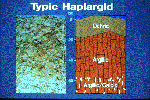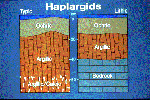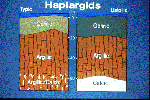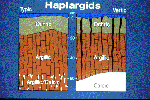Classification, Properties, and Management of Aridisols
Subgroups
 |
The next level of soil taxonomy is the Subgroup. Subgroup names
are Great Group names modified by one or more adjectives which denote
how soils differ from the typical concept of the Great Group. As
an example, we will look at a few of eighteen Subgroup classifications
of the Haplargid Great Group (originally only four, Typic, Lithic,
Ustollic and Vertic, in the 1975 edition).
|
 |
Haplargids are Argids that have weakly to moderately developed
argillic horizons. Commonly, the lower parts of the argillic horizon
have accumulations of carbonates as seen here. This Haplargid does
not differ significantly from the central concept of the Haplargid
Great Group. Thus, it is called a Typic Haplargid.
|
 |
Lithic Haplargids are like Typic Haplargids except that they have
a lithic or bedrock contact within 50 cm of the soil surface. Lithic
Subgroup classifications of Haplargids have been expanded in recent
editions of Soil Taxonomy. Now there are also Lithic Ustic
Haplargids, Lithic Xeric Haplargids, and Lithic Ruptic-Entic Haplargids
classes. These soils are rarely developed for agriculture and are
best managed as rangelands.
|
 |
Ustollic Haplargids have been deleted from the taxonomy. They were
soils with more organic matter in the ochric epipedon than do soils
of the original typic Subgroup and were an intergrade to soils in
the Mollisol Order. The soils in this class have been reassigned
by their moisture condition—that is transitional from aridic
to the moister ustic soil moisture regime—and by other criteria.
The new classes include Lithic Ustic Haplargids, Ustertic Haplargids,
Arenic Ustic Haplargids, and Ustic Haplargids.
|
 |
Vertic Haplargids have been expanded to include two additional
classes, Xerertic Haplargids and Ustertic Haplargids. They differ
from Typic Haplargids by having cracks that remain open for 8 months
or more in most years. These soils have high clay contents and are
an intergrade to the Vertisol soil Order. These Haplargids can be
agriculturally productive but, because of their high clay contents,
they require special management practices.
|
Introduction to Aridic Soils | Soil Taxonomy | Introduction to
Soil Horizons | The Horizons | Suborders and Great Groups | Argid Suborder
| Orthid Suborder | Subgroups | Families | Non-Aridisols
| Irrigation | Saline
Soils | Sodic and Saline-Sodic Soils | Final Considerations
|

